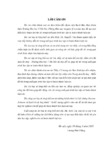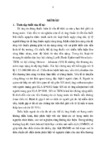
Please use this identifier to cite or link to this item:
http://dulieuso.hmu.edu.vn/handle/hmu/1658| Title: | Nghiên cứu đặc điểm lâm sàng, cận lâm sàng, mô bệnh học và hoá mô miễn dịch của hội chứng Stevens-Johnson và Lyell do dị ứng thuốc. |
| Authors: | Lương Đức, Dũng |
| Advisor: | PGS.TS. Nguyễn Văn, Đoàn |
| Keywords: | 62720109;Dị ứng và miễn dịch |
| Abstract: | THÔNG TIN TÓM TẮT NHỮNG KẾT LUẬN MỚI CỦA LUẬN ÁN TIẾN SĨ. NHỮNG KẾT LUẬN MỚI CỦA LUẬN ÁN:. Nghiên cứu tiến cứu, mô tả cắt ngang trên 60 bệnh nhân được chẩn đoán có hội chứng Stevens - Johnson (SJS) và Lyell (Toxic Epidermal Necrolysis-TEN) do dị ứng thuốc, gồm 52 bệnh nhân SJS và 8 bệnh nhân TEN tại Trung tâm Dị ứng - Miễn dịch lâm sàng, Bệnh viện Bạch Mai từ tháng 7/2013-7/2014, kết quả cho thấy:. 1. Những đóng góp mới về khoa học, lý luận:. Kết quả cho thấy một số thuốc có tỉ lệ cao là nguyên nhân gây ra hội chứng SJS và TEN, là cơ sở để các nghiên cứu sau này tập trung sâu hơn về vấn đề gen ở những người bị dị ứng với Allopurinol và Carbamazepine trong chủng tộc người châu Á.. Khẳng định vai trò của CD3, CD4 và CD8 trong quá trình hủy hoại tế bào thượng bì, gây ra quá trình chết theo chương trình. Trong đó CD8 có vai trò trực tiếp gây độc tế bào. Bổ sung cơ chế bệnh học phân tử của hội chứng SJS và TEN là cơ chế hỗn hợp có sự tham gia của nhiều yếu tố, trong đó có vai trò của CD8.. 2. Những luận điểm mới rút ra từ kết quả nghiên cứu:. - Tổn thương mô bệnh học là tiêu chuẩn để chẩn đoán phân biệt hội chứng SJS/TEN với các tổn thương da có bọng nước khác.. - Nghiên cứu lần đầu tiên cho biết tỉ lệ và mức độ xuất hiện các dấu ấn CD3, CD4 và CD8 tại các tổn thương da có bọng nước của hội chứng SJS và TEN do dị ứng thuốc, đánh giá mức độ và vị trí xuất hiện của các dấu ấn trên các lớp mô học của da.. - Kết quả nghiên cứu cho thấy có mối tương quan giữa các tổn thương hoại tử lớp thượng bì trên mô bệnh học với tình trạng thâm nhiễm các dấu ấn kháng nguyên CD3, CD4 và CD8 trên hóa mô miễn dịch./. BRIEF SUMMARY OF NEW CONCLUSIONS OF DISSERTATION. NEW THE CONCLUSION OF THE THESIS. In a prospective study, described cross on 60 patients diagnosed with Stevens- Johnson (SJS) and Lyell (Toxic Epidermal Necrolysis-TEN) due to drug allergy, including 52 patients with SJS and TEN in 8 patients Allergy Center - Clinical Immunology, Bach Mai Hospital from July/2013 - 7/2014, the results showed that:. 1. New contributions to science, reasoning:. The results show that a high percentage of the drug is the cause of SJS and TEN syndrome, is the basis for future research to focus further on the issue of genes in those allergic to Allopurinol and Carbamazepine in Asian race.. Reaffirming the role of CD3, CD4 and CD8 in the process destroying the epidermal cells, causing apoptosis process. In that role directly CD8 cytotoxic. Additional mechanisms and molecular pathology of SJS and TEN syndrome is a complex mechanism involving many factors, including the role of CD8. 2. The new arguments drawn from the findings:. - Damage to the standard histopathological diagnosis to distinguish symptoms of SJS/TEN with bullous skin lesions with others.. - Research for the first time that the rate and degree of occurrence of CD3 markers, CD4 and CD8 in the bullous skin lesions with SJS and TEN symptoms of allergy medications, evaluate the extent and location production of the markers on the histological grade of leather.. - Results of the study showed a correlation between the necrotic lesions on the epidermis histopathological status infiltration of CD3 antigen markers, CD4 and CD8 on immunohistochemistry./ . |
| URI: | http://dulieuso.hmu.edu.vn//handle/hmu/1658 |
| Appears in Collections: | Luận án (nghiên cứu sinh) |
Files in This Item:
| File | Description | Size | Format | |
|---|---|---|---|---|
| 100_Luan an - Dung DU.pdf Restricted Access | 4.32 MB | Adobe PDF |  Sign in to read | |
| 100_TT 24- Dung DU.pdf Restricted Access | 856.25 kB | Adobe PDF |  Sign in to read |
Items in DSpace are protected by copyright, with all rights reserved, unless otherwise indicated.